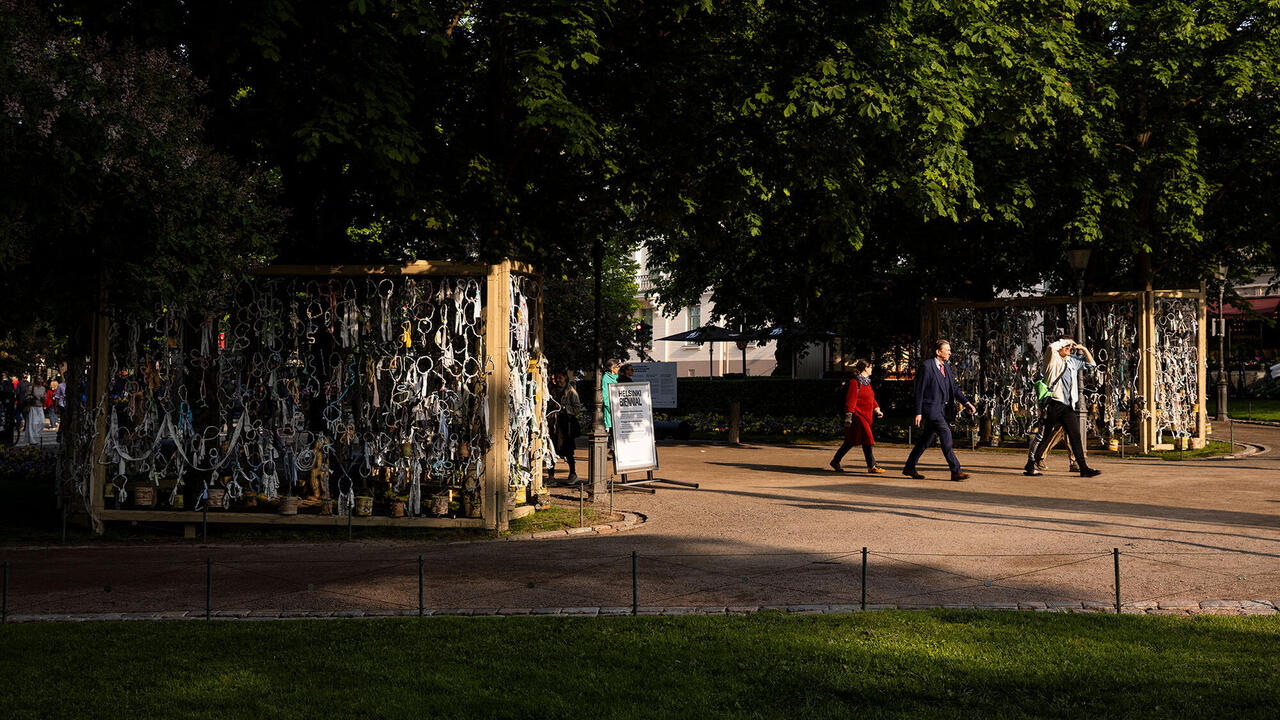On Kawara: The Recording Angel
On Kawara did not attend the opening of his current retrospective at the Nouveau Musée in Villeurbanne, nor did he assist with its installation. Instead, the museum staff executed his plans while he stayed home in New York
On Kawara did not attend the opening of his current retrospective at the Nouveau Musée in Villeurbanne, nor did he assist with its installation. Instead, the museum staff executed his plans while he stayed home in New York
On Kawara did not attend the opening of his current retrospective at the Nouveau Musée in Villeurbanne, nor did he assist with its installation. Instead, the museum staff executed his plans while he stayed home in New York. This should have come as no surprise, since his absence has always been crucial to his art. Kawara finds other ways of communicating, such as postcards, or telegrams. One long-term preoccupation in these missives has been the fact of his own existence - 'I Am Still Alive', inscriptions proclaim, and will continue to do so even after his death. Earlier, less formal messages to friends read: 'I am not going to commit suicide. Don't worry' or 'I am not going to commit suicide. Worry'. This terse style persisted in another group of works, also couched in the first-person singular, this time celebrating daily activities. The messages took different forms: I Read, with details of what he had read; I Met, with a list of people he had encountered that day. Kawara's triumph has been to dignify such notes, not by turning them into autobiography but instead by reducing them to ciphers, partly by means of repetition.
For example, in the entrance hall at Villeurbanne stood two sets of vitrines containing books - some open - of consecutive, printed dates spanning vast periods of time: One Million Years - Past (1970)on one side and One Million Years - Future (1980) on the other. The Past begins in 998,031 BC and ends in 1969; the Future ends in 1,000,980 AD, and is dedicated 'For the last One'. Accompanying these books in their cases was a sound tape of a man and a woman taking turns to read the numbers. The result was a study of the need for measurement despite its futility. What prevents Kawara's work from being science is the concentration on his own life, his own choice of measurement and his personal grasp of time. (His regard for the quotidian, on the other hand, is what prevents him thinking like an old-fashioned historian.)
More complex are his daily activities. Henning Weidemann remembered following Kawara around his loft one morning. First, he reported, Kawara printed I Got Up postcards, with the time and the addressee. He worked on a date painting then turned his attention to One Million Years. I Am Still Alive followed, then I Read. After that, he drew on a city map, and began a date painting which had to be finished by midnight. A calendar needed stamping, and the total of date paintings for that year had to be altered, then the number of works that year. At the end of the day he would enter (under I Met...) all the people he had encountered on that day and add a green dot for the creation of the date painting. All these actions have increased in complexity as time has gone on. So much so that gradually the general headings for different series - I Got Up, I Met, I Went, I Read - seem to evade their separate categories and become part of an exercise far more complex than mere headings could convey. All times, for example, were given in terms of US Eastern Standard Time, 'except for those from April 25 through October 29, which are in Daylight Saving Time in accord with American custom.' Why should an artist take such scrupulous care? Saul Bellow wrote a novel called Seize the Day. The title might be a perfect description of the work of On Kawara.
Seizing the day may be more difficult than it seems. Otherwise known as the 'Today' series, the Date Paintings began early in 1966. Consisting of simply a white date painted on a monochrome background, each one had a box to contain it, with a sticker and a date on the lid, and a newspaper cutting on the bottom. Also inside the boxes were notes by the artist himself. The definition of the exercise altered as time passed, creating variations and subtexts. 'This painting itself is January 15, 1966', Kawara wrote that day. On November 18 of the same year he noted 'I collect the painted days'. And on July 25 he wrote 'I make love to the days'. So - for him, at least - the series could reflect moods and even become a surrogate for his life: the date paintings were far more than arbitrary numbers.
The cool presentation of facts distinguishes Kawara's style: ranging from notes to friends at the one extreme to huge books of plain, mechanical facts on the other. Yet the discovery is that there are no 'plain' facts at all. Like wandering through a graveyard, the experience of registering ostensibly neutral information can be a highly emotive experience. For without our realising it, the artist conducts a meditation on living and dying. In a way that is apparently simple, On Kawara shows markers in time and space and allows us to move through them. The sense is of a single person in touch with others while experiencing a monastic solitude in which ritual movements cannot be avoided. We sacrifice our selfhood in Kawara's repetitions as different aspects of his practise surface in our minds; as the cogs of logic cease to engage, the impression of a personality is lost and individuals blend with others. On the one hand, this is the definition of a society, but on the other, it indicates a broad view of history, which most resembles the method of the French historian Fernand Braudel.
Braudel, who argued 'There is no unilateral history', wrote of different time spans which events might take. One was short: micro-history in all its immediacy, the concern of narrative. Another was an intermediate process of change to which he gave the term 'conjonctures' - larger movements of social and political structures, a slower pace. The longest duration, in his view, was the histoire de la longue durée, where time scarcely seems to move. Events in themselves held little interest for Braudel, who regarded them as an illusion. The earth itself could be more important than mere events; permanence and survival eclipsed other factors to make mere events seem like fireflies in the darkness, more apparent than real. Beyond this, little change would occur. In this view, destiny triumphs over free will. Would it be heretical to regard this as the dominant metaphor in Kawara's art, attuned to periods of time which do not quite evade translation into numerical form but which succeed in presenting numbers for which no easy equivalent will suffice?
Lost in these vast imaginary spaces, some commentators have appealed to religion. As Jean-Louis Maubant argued in the catalogue to the Villeurbanne exhibition, Kawara could be presenting 'the Baroque work of art par excellence, the work a mirror which lifts our deep insignificance to the heights.' For Kawara's, he proceeds to argue, is an art with 'considerable moral weight and terrifying accusatory force'. Certainly, it communicates by means of an unexpected simplicity and power; direct messages highlight inescapable problems, while at every moment matters of life and death are broached and grandeur and beauty are manifested. If the architectural style we call Baroque can be summarised as a shaft of light illuminating a lone figure, like Bernini's The Ecstasy of St. Teresa (1644-47), it may indeed have something to do with the world as Kawara sees it.
Ad Reinhardt wrote: 'The less an artist obtrudes himself in his painting, the purer and clearer are his aims'. Kawara is such an artist; although we know what he does, who he meets, even the time he gets up, Kawara keeps his distance from the audience, destroying any trace of a character, a set of motives or a photograph of himself. Perhaps only Andy Warhol, who wore cheap wigs and cosmetics and employed a team of look-alikes to make life easier for himself, would have understood fully why Kawara was prepared to adopt such tactics. Reinhardt, Warhol, Kawara... Take them together and suddenly Maubant's description of an art with 'terrifying accusatory force' may seem justified. A Reinhardt cartoon, a Warhol race riot painting and Kawara's Vietnam triptych (Title, 1965) impress us both because of their historical acumen and the way they leap out of their frames. One of the earliest works in the Villeurbanne exhibition was a line drawing of a baby, either laughing or screaming. Could this have been Kawara's response to Hiroshima?
The measurement of time and its intersection with space provides the basis of Kawara's project, while the everyday provides apparently endless - but seldom surprising - variations, constantly shot through with movement while remaining more or less the same, like a running bassline in music. In these terms, but in three dimensions, artworks occur: solid enough, but also bearing words. It is important that such paintings have depth; their object nature must be recognised. That they employ words is necessary too; these pictures communicate by signals rather than explanation, with facts and nothing else. In such terms, religion arises again - the paintings most of all resemble gravestones, aids to meditation, for they fall somewhere between reference and reality: that which exists in the here and now and that which points to the past. Indeed, in his dedication to working on repetitious projects day after day Kawara resembles a secular monk, praying for the world. The constant activity involved leaves the mind open for ideas. And the idea of the world that arises is of being inside looking out, not the opposite, and of communication for its own sake. Kawara's dedication, the fact that his practise never flags, the fact that the very repetition of his moves aligns him more with the concept of a traditional weaver than with the usual idea of a 20th-century artist, reveals the pattern that can be discerned within the entire plan. 'Lifting deep insignificance to the heights', Maubant wrote, a surprisingly active metaphor for an artist so ostensibly passive. The quotidian may be undramatic, but it is all we have. Kawara invites us to meditate on it and with it creates great, unheard symphonies.
















